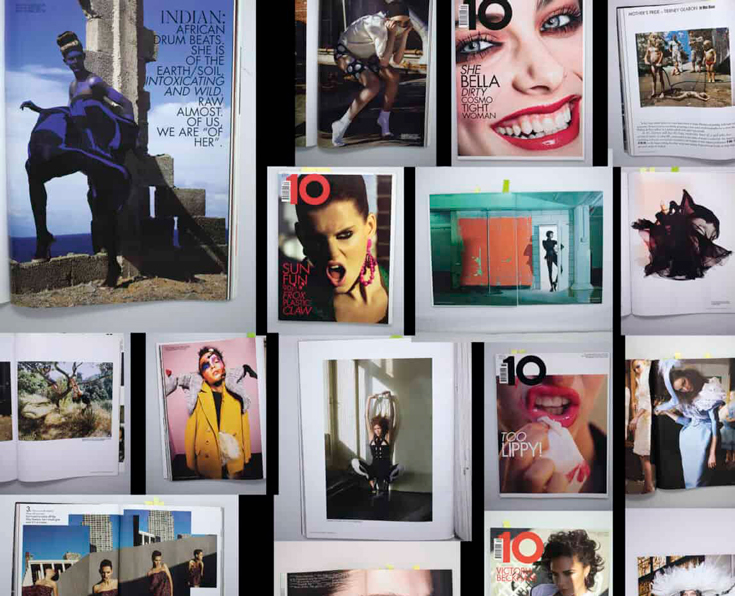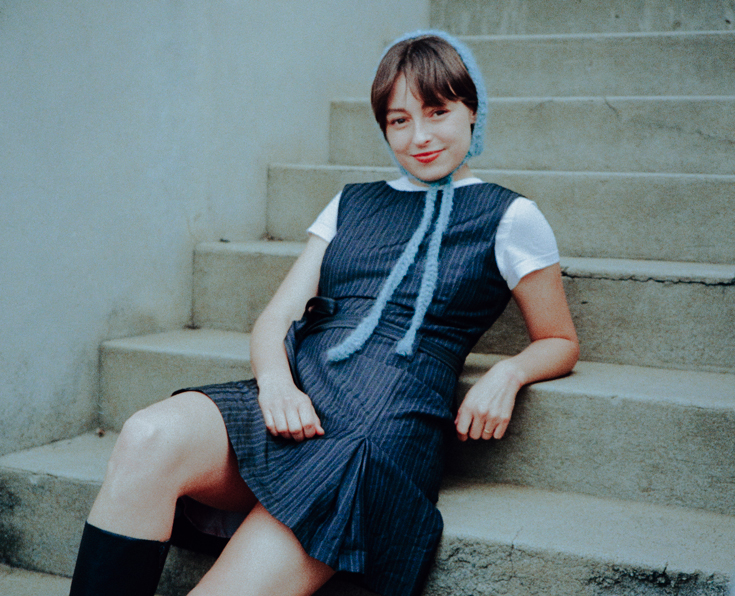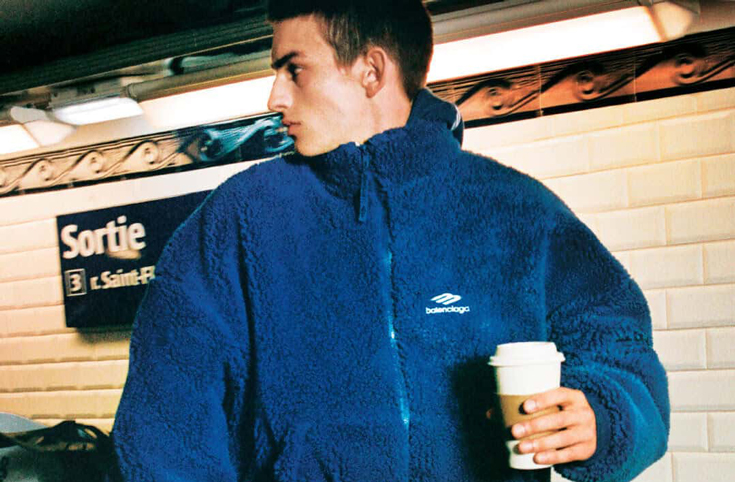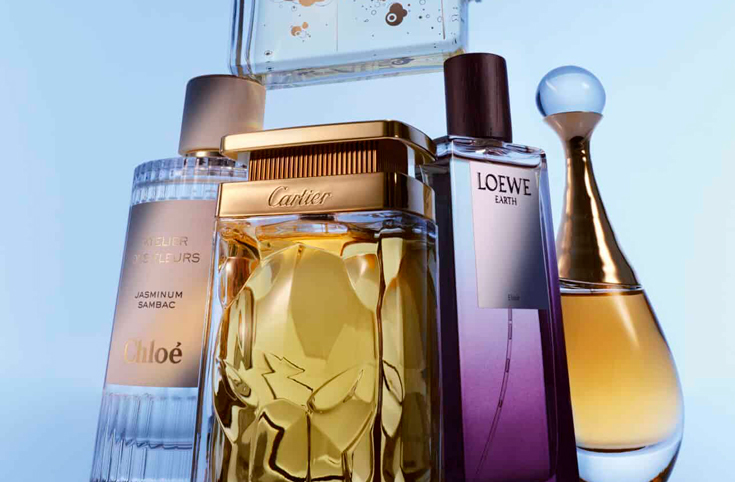SCHIAPARELLI’S DANIEL ROSEBERRY ON CREATING FASHION FANTASY

“I’m not a big dreamer at night. I’m a daydreamer,” says Schiaparelli’s Daniel Roseberry, a man who has energised fashion with the soaring fantasy of his creations. Joining the historic French couture house in 2019, Roseberry recast the red carpet, taking it from a safe, patrician power walk to a playground for statement-making spectacle and glorious self-expression.
“I don’t think people want Zara-for-rich-people clothes here,” says the designer over Zoom from his Paris office, with the bustle of the Place Vendôme as his backdrop.
Whether it’s Doja Cat in a red skirt and corset, complete with red paint and 30,000 body crystals, Lady Gaga in a bulletproof presidential-inauguration gown, Kylie Jenner sporting a couture dress adorned with an ultra-realistic-but-totally-fake lion’s head, or Cardi B taking to the streets of Paris in a tweed skirt suit complete with golden breasts, Roseberry showed celebrity dressing can be a creative endeavour. “We have redefined the way celebrities feel they can dress on the red carpet,” he says.
In 2022, he brought his vision to ready-to-wear, creating wearable pieces, cut with couture precision, lavished with his signature wit and worn with bankable gilded accessories. If his couture revels in artistry and fantasy, then his ready-to-wear is grounded in wardrobe pieces that have a sense of drama. Couture and ready- to-wear are, he says, for the “same woman, different time, different moment. The couture is for the most precious moment of her life.” But whatever collection his customers are shopping from, they’re looking for the same thing. “It’s that desire for the extraordinary,” he says.
Roseberry’s spectacular Schiaparelli success has not come out of the blue. The time is right. His era is now. “When John [Galliano] left Dior [in 2011] and when Lee [McQueen] died [in 2010], that was really the turning of the page, where the dream world of fashion for the sake of dream fashion became obsolete. And then it ushered in a new chapter, which was, for me, the Phoebe [Philo] chapter, the Raf [Simons] at Dior chapter, which was much more minimalistic and about reality and speaking to someone’s daily life. But I feel like my chapter, this chapter, this era, is about synergising the two worlds,” he explains.
And not a moment too soon.“The pendulum swung so far into that reality. You know, I don’t even want to hear the words ‘quiet luxury’ again. But it can’t just be surrealism either. What’s unique is that we balance, we walk the line between those two extremes.”
For Roseberry, the brand’s burgeoning ready-to-wear line is a vital part of story. He describes it as “an everyday sensation” and is intent on creating clothes and accessories that sing with style, surprise and individuality. You can scratch the surreal itch with an immaculately cut navy blazer with buttons that look like golden nipples, pour yourself into an hourglass denim jacket with hand- made bijoux buttons and pointy breasts, or trot around town in a pair of pumps with golden trompe-l’oeil toes. “We are taking those surrealist elements, the fantasy, the dream world, but grounding it in archetypal pieces, archetypal fabrics like denim. It’s something we already have a relationship with, but it’s reinvented and infused with this… charisma.”
The idea is not to completely re-envision what piece is. Roseberry says it’s about “reimagining how extraordinary we can make it in the fabrication, the visual, the buttons, and making sure that execution is just superior,” he says. The biggest difference between his ready-to-wear and his couture? “It only takes one person to dress you, not two.”

Regardless, it’s all designed with the same intention. “The same thing that will melt the internet will also mean your daily life is just extraordinary,” he says. He loves it when customers tell him, as they often do, that they can’t walk down the street wearing his designs without being stopped and complimented on their Schiap pieces. Launching ready-to-wear has complicated his world. “It has added another element of pressure. But I’m thrilled to be showing it because I think it deserves to be shown and I don’t want the house just to be known for this dream-like celebrity-driven couture. We need to cut it with something real. And that is the challenge of the next chapter at Schiaparelli.”
Roseberry was raised in Dallas, Texas, the son of a preacher. A keen artist, his first dream was to be a Disney animator. Pocahontas was his favourite character and Michelle Pfeiffer’s Catwoman also made a lasting impression. “I went to church with a friend also named Daniel. He liked drawing, too. I looked over at his page and he was drawing Jesus on a cross on the hilltop and I was drawing Catwoman, by memory, with all of the staples of her latex bodysuit. He was scandalised.”
Growing up religious and gay, he felt that crisis of identity keenly. His creative talent brought him to New York, where he flourished after dropping out of the Fashion Institute of Technology to work
for Thom Browne, eventually becoming his right-hand man, before moving to Paris for Schiaparelli. Gradually, he’s reconciled himself with personal and professional paradoxes and now leans into them. “There’s this idea of contradiction, of two things being true at the same time. It is so who I am, you know. I’m in double denim on the Place Vendôme.” He means it creatively as well as personally and connects that contradiction back to the house. “Elsa Schiaparelli was an Italian working in Paris. She was admittedly not that gorgeous but making glamorous clothes. She was living in this space, working the tension between art and fashion, and always walking the line between humour and austerity.” Keeping that at the forefront of his mind enables him to navigate the traps of taste and tone.
“It should never be camp, it should never be comical, or ironic or cynical. There’s a unique brand of humour that we possess, as part of the heritage, that is always undercut with austerity and that sense of what she called ‘hard chic’. I find a lot of security in that.”

Roseberry is most creative in his daydream state, but concedes the increasing challenge of getting there, “because you have to be in a place of low stress, low pressure. That’s the hardest part, to find a place of safety and security, where you can be free to dream like you did before you became a creative director. And no one tells you that. No one tells you that the work you do before you get your dream job will be the first thing that is under attack once you get it.”
The designer rarely finds the peace he needs at home or in the studio. “It’s always a solitary place, normally travelling. Almost never in Paris. It’s normally in transit from one place to another,” he says. He has friends who live in central Switzerland, a seven-hour train ride from Paris that he’s come to relish. “I will literally go to see them for 24 hours,” he says. “Seven hours there, seven hours back – it’s like the great unburdening.”
The soundtrack to support his creative process is “absolutely critical. When Apple introduced those noise- cancelling headphones, I feel like my work took a jump forward.” His playlist could be anything from Mahler to Taylor Swift. “It’s always that tension between pop and something more classic.” Then he pulls out his notebook (“It’s graph paper, filled with notes, journal entries, drawings, architectural plans of houses that I don’t own and probably never will.”) and goes into his imagination.
In many ways he’s trying to reconnect with the little boy who drew for pure pleasure in church. The ideas come thick and fast when he’s in that childlike state of creation, but he cautions, “the fashion industry seems dedicated to taking that away from you from day one. The critics, the rhythm of the industry, having to release a minimum of four ground-breaking, internet-breaking, crowd- pleasing, critic-pleasing collections a year with maybe 10 days in between… that is insane. That’s why so many creative directors fall into this trap of addiction or bad behaviour.”

He revels in being at a house powered by creativity. “Too many big brands have forsaken creativity for the numbers. The aim is to ensure the brand is the star, not the creative director. I’m so happy to be at a house right now where we are not playing that game. And I think people really value the alternative to that, because it’s not speaking to the child inside.” The fashion pendulum, he says, is swinging his way.
“I think that there will come a day, probably not so far in the future, where the power of the brand will not be what sustains it. It will be a new creative vision that sustains it and ushers in a new chapter. When John [Galliano] was at Dior or when Karl was at Chanel, these were radically dreamlike, fantastical shows that would then fuel a business.” He was speaking a few weeks before Galliano showed his spectacular, theatrical SS24 couture show for Maison Margiela.
It’s typical of Roseberry to say things that other designers can’t or won’t. Four years after moving to Paris he’s still ambivalent about living in the city. His routine is work, sleep, repeat, with an ultra-tough boot camp session or flea market jaunt at the weekend. He struggled with life there at first. “It’s a beautiful, boring backdrop for the best job in the world. I’m more and more at peace with that,” he says. He’s equally candid when talking about his own work. “The beginning of each season, I print out the last one. And I’ll look at it and be like, ‘Fail! Fail! Fail! Success! Success! Fail! Fail!’ It’s about learning, about refining the process. I think that I learn more from the failure collections.” This unflinching critique is, he says, part of his process.
“When we did the gold collection [SS22 couture], I think that hit the moment. The inferno collection [SS23 couture] hit the moment. The matador collection [AW21 couture] hit the moment. The collection that we did with all the flowers [AW22 couture] was divine and beautiful and so fabulous in person, but it didn’t speak to our cultural moment as much as it should,” he says. It matters because couture cuts deeper. “The ready-to-wear is about the mastery of clothing. And the couture is about the mastery of the moment. It’s about nailing the cultural moment. And if we really hit the moment, we can generate $50 million worth of press in 30 minutes.” With his instinct for pop culture and fashion artistry, Roseberry is a genius at doing just that. Schiaparelli: the small house, with the big voice, shines on.
Taken from 10 Magazine Issue 23 – DARE TO DREAM – out now.

SCHIAPARELLI: THE PARTY
Photographer DONNA TROPE
Fashion Editor SOPHIA NEOPHITOU
Text CLAUDIA CROFT
Model VALERY KAUFMAN at Elite Paris Sittings
Editor GARTH ALLDAY SPENCER
Hair SEBASTIEN BASCLE at Calliste Agency
Make-up CHRISTOPHER ARDOFF at Art Department
Manicurist CHRISTINA CONRAD at Calliste Agency using Gold Sand by Manicurist Photographer’s assistant HUGO FAZI
Fashion assistants GEORGIA EDWARDS and SONYA MAZURYK
Digital operator LOUIS CLERC
Casting SIX WOLVES
Production ZAC APOSTOLOU
Location SCHIAPARELLI, Place Vendôme, Paris
Special thanks to JOEL TREVINO, JEANNE TERRIER and the SCHIAPARELLI TEAM
Clothing and accessories throughout by SCHIAPARELLI SS24 Ready-to-Wear Collection











